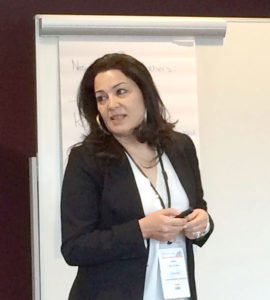[vc_row][vc_column][vc_column_text]
In Tunisia, public health approach offers hope to stem violent extremism
By Jillian Slutzker
[/vc_column_text][/vc_column][/vc_row][vc_row][vc_column width=”2/3″][vc_column_text]AARHUS, Denmark — A method to prevent gang joining that was pioneered in Los Angeles and adapted to Central America is now being used in Tunisia to reach youth most at risk of joining violent extremist organizations before they make that move.
Known as the public health approach, the model focuses on diagnosing levels of vulnerability to the epidemic of violence and aims to pair the appropriate treatment, or medicine, to an individual’s level of risk.
“The way we view violence through the public health approach is that it acts as a disease. It spreads from person to person. It transmits from neighborhood to neighborhood to persons who are at risk,” explained Enrique Roig, Director of Citizen Security at Creative Associates International at the Strong Cities Network Global Summit and the Building Resilience to Radicalisation and Violent Extremism II conference in Aarhus, Denmark on May 19.
Roig was joined by Halima Mrad, Chief of Party for the U.S. State Department-funded Ending Terrorism through Youth Service Action Locally program, for a conference workshop called “Public Health Approach for Addressing CVE in Tunisia: What Are We Learning from the Gang Prevention Field?”.
Public health approach explained

Within a high violence area, the number of individuals who will actually commit violence and are therefore in need of intensive violence prevention treatment is a relatively small percentage, explained Roig.
The public health model takes a four-legged approach to violence prevention: primary prevention for the general population in a high violence area; secondary prevention for those most at-risk of getting involved in violence; tertiary prevention, such as re-entry for former members of violent groups; and law enforcement interventions for more hardened offenders.
Programs can more effectively stem violence by focusing on those at a secondary level of risk who are most likely to join a violent group, said Roig. Typically, studies show that these are youth ages 10 to 25, depending on the country context.
“There are other things happening in their lives in addition to living in a hot spot neighborhood that makes them more likely to get involved with a gang or join a violent extremist organization,” he added.
To identify those youth, Creative use a data-driven method known as the Youth Service Eligibility Tool, which assesses youth risk across individual, peer and family level domains using a series of nine risk factors—such as a critical life event, substance abuse or negative peer influence.
After identifying those at a secondary level of risk, trained family counselors work in close partnership with youth and their families over the course of a year to address problem-solving, change negative family dynamics and lower the risk factors for joining a violent group.
Applying lessons from gang prevention to CVE in Tunisia
The Ending Terrorism through Youth Service Action Locally program—or ETTYSAL which means “reaching out” in Arabic—is taking a page from gang violence prevention to tackle an ever growing problem of youth radicalization and recruitment to violent extremism in the country.
An estimated 6,000 Tunisians have left the country to join the violent extremist organization known as the Islamic State in Iraq and Syria. The majority of them are youth.
“It really touches one of the most important issues we’re dealing with in Tunisia,” said Halima Mrad, Director of the program, which is implemented by Creative.
The project works with 100 youth ages 14 to 23 in the towns of Manouba and Kasserine—two hot spots for violent extremist recruitment.
The program has adapted a version of the Youth Service Eligibility Tool to the local context. In addition to the nine risk factors used in the original tool, the program has added three factors based on focus groups with youth and research of local universities. They are social vulnerability, religious extremism manifested in concerning behaviors such as accusing others of disbelief, and religious extremism displayed in alarming behaviors such as isolating oneself from friends and spending hours on extremist social media networks.
The risk assessment framework used in gang violence prevention in Central America is remarkably relevant in the Tunisian context.
“There are a lot of similarities [between factors for joining a gang or a violent extremist organization], including the personal connection to violent group, critical life events, family dysfunction and negative peer influence,” said Mrad.
She noted some of the risk factors that make a young person more vulnerable to joining a violent extremist group, including marginalization and antisocial tendencies, a sense of injustice, a feeling of disconnection from family or a lack of belonging, a drive for heroism and risk-taking, and peer influence toward radicalization, among others.
After a period of research, adaptation and training followed by referrals and assessments of youth, the program is now two months into a twelve-month course of family counseling. The counselors, whom Mrad calls the “champions” of the program, come from the same communities as the families they serve and have backgrounds in youth development and prevention work.
While the course of counseling is not yet complete, Mrad said the counselors are already witnessing positive behavioral changes in the young people with whom they work.
Mrad anticipates that these behavioral changes will be displayed in a reduction in risk factors on their upcoming six-month risk assessments and that the program will be able to reach these youth before they go down the path of violent extremism.
“It’s really a PVE program. We’re preventing youth from getting radicalized,” she said. “We try to help them at the very first stage when we first see the symptoms of youth getting radicalized.”[/vc_column_text][/vc_column][vc_column width=”1/12″][/vc_column][vc_column width=”1/4″][vc_widget_sidebar sidebar_id=”sidebar-primary”][/vc_column][/vc_row]